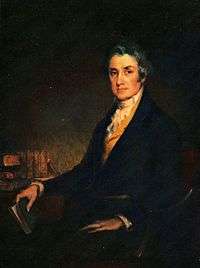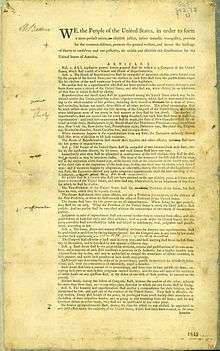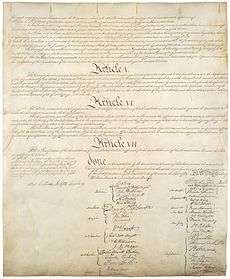Abraham Baldwin
| Abraham Baldwin | |
|---|---|
 | |
| President pro tempore of the United States Senate | |
|
In office December 7, 1801 – December 13, 1802 | |
| Preceded by | James Hillhouse |
| Succeeded by | Stephen R. Bradley |
| United States Senator from Georgia | |
|
In office March 4, 1799 – March 4, 1807 | |
| Preceded by | Josiah Tattnall |
| Succeeded by | George Jones |
| Member of the U.S. House of Representatives from Georgia's at-large district | |
|
In office March 4, 1793 – March 3, 1799 | |
| Preceded by | district created |
| Succeeded by | James Jones |
| Member of the U.S. House of Representatives from Georgia's 2nd district | |
|
In office March 4, 1789 – March 3, 1793 | |
| Preceded by | district created |
| Succeeded by | Converted to at-large districts |
| President of the University of Georgia | |
|
In office 1785–1801 | |
| Preceded by | none |
| Succeeded by | Josiah Meigs |
| Delegate from Georgia to the Congress of the Confederation | |
|
In office 1785 – 85, 1787–88 | |
| Personal details | |
| Born |
November 22, 1754 Guilford, Connecticut |
| Died |
March 4, 1807 (aged 52) Washington, D.C. |
| Resting place | Rock Creek Cemetery, Washington, DC |
| Alma mater | Yale University |
Abraham Baldwin (November 22, 1754 – March 4, 1807) was an American minister, Patriot, politician, and Founding Father. Born and raised in Connecticut, he was a graduate of Yale University Divinity School. After the Revolutionary War, Baldwin became a lawyer. He moved to the U.S. state of Georgia in the mid-1780s to work.
Early life, education and career
Abraham Baldwin was born in 1754 in Guilford, Connecticut into a large family. His father was a blacksmith. His half-brother, Henry Baldwin, was an Associate Justice of the Supreme Court of the United States. After attending a local village school, Abraham Baldwin attended Yale University in nearby New Haven, Connecticut, where he was a member of the Linonian Society. He graduated in 1772.
Three years later after theological study, he became a minister. He also served as a tutor at the college. He held that position until 1779. During the American Revolutionary War, he served as a chaplain in the Connecticut Contingent of the Continental Army. He did not see combat while with the Continental troops.[1]
Two years later at the conclusion of the war, Baldwin declined an offer from Yale for a divinity professorship. Instead of resuming his ministerial or educational vocation after the war, he turned to the study of law. In 1783 he was admitted to the bar.
Move to Georgia
Baldwin was recruited by Governor Lyman Hall of Connecticut to work for the Georgia governor in developing a state education plan. He moved to Georgia, where he became active in politics to build support for a college. He was appointed as a delegate to the Confederation Congress and the Constitutional Convention, and was one of the state’s two signatories to the U.S. Constitution.
Abraham Baldwin was appointed in 1785 to serve as the first president of the University of Georgia during its initial planning phase to 1801. During this period, he also worked with the legislature on the college charter.
In 1801, Franklin College, UGA's initial college, opened to students. Josiah Meigs was hired to succeed Baldwin as first acting president and oversee the inaugural class of students. The first buildings of the college were architecturally modeled on Baldwin's and Miegs's alma mater of Yale where they both we educators . (Later the university sports team adopted as its mascot, the bulldog, also in tribute to Baldwin and Miegs, as it is the mascot of Yale.)
Politics

Baldwin was elected to the Georgia Assembly, where he became very active, working to develop support for the college. He was able to mediate between the rougher frontiersmen, perhaps because of his childhood as the son of a blacksmith, and the aristocratic planter elite who dominated the coastal Lowcountry. He became one of the most prominent legislators, pushing significant measures such as the education bill through the sometimes split Georgia Assembly.[1][2]
He was elected as representative to the U.S. Congress in 1788. The Georgia legislature elected him as U.S. Senator in 1799[3] (this was the practice until popular election in 1913.) He served as President pro tempore of the United States Senate from December 1801 to December 1802. He was re-elected and served in office until his death.
Death and legacy
On March 4, 1807, at age 52, Baldwin died while serving as a U.S. senator from Georgia. Later that month the Savannah Republican and Savannah Evening Ledger reprinted an obituary that had first been published in a Washington, D.C., newspaper: "He originated the plan of The University of Georgia, drew up the charter, and with infinite labor and patience, in vanquishing all sorts of prejudices and removing every obstruction, he persuaded the assembly to adopt it."[4]
His remains are interred at Rock Creek Cemetery in Washington, DC.[5]
Honors
- The United States Postal Service made a 7¢ Great Americans series postage stamp in his honor;
- Places and institutions were named for him, including:
- Baldwin County in Alabama and Georgia;[6]
- Abraham Baldwin Agricultural College in Tifton, Georgia;
- Abraham Baldwin Middle School in Guilford, Connecticut;
- Baldwin streets in Madison, Wisconsin[7] and Athens, Georgia;
- The University of Georgia erected a statue of Baldwin on the historic North Campus quad in his honor as its founding father.[8]
See also
References
- 1 2 Wright, Jr., Robert K.; MacGregor Jr., Morris J. (1987). "Abraham Baldwin". Soldier-Statesmen of the Constitution. Washington D.C.: United States Army Center of Military History. LCCN 87001353. OCLC 15549460. CMH Pub 71-25. Retrieved November 9, 2013.
- ↑ Rowe, H.J. (2000). History of Athens & Clarke County. Southern Historical Press.
- ↑ Congressional Biography
- ↑ "Abraham Baldwin (1754–1807)", New Georgia Encyclopedia (January 6, 2009), Retrieved on July 21, 2013
- ↑ Abraham Baldwin at Find a Grave
- ↑ Krakow, Kenneth K. (1975). Georgia Place-Names: Their History and Origins (PDF). Macon, GA: Winship Press. p. 13. ISBN 0-915430-00-2.
- ↑ Odd Wisconsin Archives. Wisconsinhistory.org (March 29, 2006). Retrieved on 2013-07-21.
- ↑ "Special Report on the Abraham Baldwin Statue Initiative". UGA's External Affairs. n.d. Retrieved February 10, 2013.
- United States Congress. "Abraham Baldwin (id: B000084)". Biographical Directory of the United States Congress.
| U.S. House of Representatives | ||
|---|---|---|
| Preceded by New Seat |
Member of the U.S. House of Representatives from Georgia's 2nd congressional district March 4, 1789 – March 4, 1793 |
Succeeded by Converted to At-Large districts |
| Preceded by Converted from district seats |
Member of the U.S. House of Representatives from Georgia's at-large congressional district March 4, 1793 – March 4, 1799 |
Succeeded by James Jones |
| U.S. Senate | ||
| Preceded by Josiah Tattnall |
U.S. Senator (Class 2) from Georgia March 4, 1799 – March 4, 1807 Served alongside: James Gunn, James Jackson, John Milledge |
Succeeded by George Jones |
| Political offices | ||
| Preceded by James Hillhouse |
President pro tempore of the United States Senate December 7, 1801 – December 13, 1802 |
Succeeded by Stephen R. Bradley |



